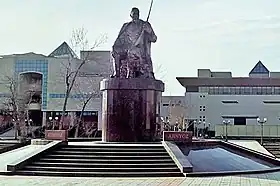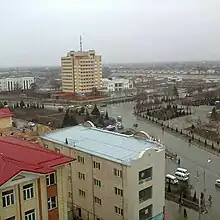Nukus
Nukus (Karakalpak: Nókis / Нөкис; Uzbek: Nukus / Нукус) is the sixth-largest city in Uzbekistan and the capital of the autonomous Republic of Karakalpakstan. The population of Nukus as of 1 January 2022 was 329,100.[1] The Amu Darya river passes west of the city. Administratively, Nukus is a district-level city, that includes the urban-type settlement Karatau.[2]
Nukus
| |
|---|---|
     | |
 Seal | |
 Nukus Location in Uzbekistan | |
| Coordinates: 42°28′N 59°36′E | |
| Country | |
| Sovereign Republic | Karakalpakstan |
| Established | 1860 |
| Government | |
| • Type | City Administration |
| Area | |
| • Total | 222 km2 (86 sq mi) |
| Elevation | 76 m (249 ft) |
| Population (2022)[1] | |
| • Total | 332,500 |
| • Density | 1,500/km2 (3,900/sq mi) |
| Postal code | 2301xx |
| Area code | (+998) 61 |
| Website | www |
The city is best known for its world-class Nukus Museum of Art.
History
The name Nukus comes from the old tribal name of the Karakalpaks, Nukus.[3] Nukus developed from a small settlement in 1932 into a large, modern Soviet city with broad avenues and big public buildings by the 1950s.
The city's isolation made it host to the Red Army's Chemical Research Institute, a major research and testing center for chemical weapons. In 2002 the United States Department of Defense dismantled the Chemical Research Institute, the major research and testing site for the Novichok agent, under a $6 million Cooperative Threat Reduction program.[4][5]
Turtkul city became the administrative center of the autonomous region of Karakalpakstan when the Soviet authorities came to power. However in the 20s, Amu Darya, which was 12 km from the River Bank, was threatened with the flush of Turtkul, which caused the core of Karakalpakstan to move towards Nukus. In 1932 the city was officially founded. It is the center of Karakalpakstan's economy, government, politics and culture.[6]
Sights

Nukus is host to the Nukus Museum of Art (also known as the State Art Museum of the Republic of Karakalpakstan, named after Igor Savitsky) and State Museum. The State Museum houses the usual collection of artifacts recovered from archaeological investigations, traditional jewelry, costumes and musical instruments, displays of the area's now vanished or endangered flora and fauna, and on the Aral Sea issue. The Art Museum is noted for its collection of modern Russian and Uzbek art from 1918 to 1935. Stalin tried his best to eliminate all non Soviet art from this period, and sent most of the artists to the gulag. Both Savitsky himself and the collection at Nukus survived because the city's remoteness limited the influence and reach of Soviet authorities. The documentary film The Desert of Forbidden Art is all about the collection and its history.[7]
Nukus is also home to the Amet and Ayimkhan Shamuratovs house museum, a hub for Karakalpak music and oral culture. The museum's collection represents personal belongings of the Shamuratovs including stage clothes, photographs, manuscripts, books, letters.[8]
Nukus and the surrounding area is serviced by Nukus Airport.
Climate
Nukus experiences a cold desert climate (Köppen BWk) with summers that are long, dry and very hot, and winters that are short, though quite cold and snowy, having a very dry type of a continental climate. Due to the Aral Sea and Amu Darya drying up, the climate has become much hotter and drier since 1960, and health conditions resulting from salt and other chemicals in the air have become more common. [9]
| Climate data for Nukus (1981–2010) | |||||||||||||
|---|---|---|---|---|---|---|---|---|---|---|---|---|---|
| Month | Jan | Feb | Mar | Apr | May | Jun | Jul | Aug | Sep | Oct | Nov | Dec | Year |
| Average high °C (°F) | 0.7 (33.3) |
4.0 (39.2) |
11.7 (53.1) |
21.7 (71.1) |
28.7 (83.7) |
34.5 (94.1) |
36.2 (97.2) |
34.3 (93.7) |
27.9 (82.2) |
19.4 (66.9) |
10.0 (50.0) |
3.1 (37.6) |
19.4 (66.9) |
| Average low °C (°F) | −7.5 (18.5) |
−6.0 (21.2) |
−0.1 (31.8) |
8.2 (46.8) |
14.2 (57.6) |
19.1 (66.4) |
21.3 (70.3) |
18.9 (66.0) |
12.0 (53.6) |
4.9 (40.8) |
−0.8 (30.6) |
−5.5 (22.1) |
6.6 (43.9) |
| Average precipitation mm (inches) | 10.8 (0.43) |
9.6 (0.38) |
17.1 (0.67) |
15.4 (0.61) |
12.2 (0.48) |
4.1 (0.16) |
2.7 (0.11) |
1.6 (0.06) |
2.4 (0.09) |
6.9 (0.27) |
12.5 (0.49) |
11.8 (0.46) |
107.1 (4.22) |
| Average precipitation days | 11 | 10 | 9 | 8 | 8 | 5 | 4 | 2 | 3 | 5 | 8 | 10 | 83 |
| Source: Centre of Hydrometeorological Service of Uzbekistan[10] | |||||||||||||
Economy
In 2019, the Nukus free economic zone (FEZ) was established to "attract direct foreign and domestic investments for the production of import-substituting products that are in demand on foreign markets". This FEZ will be in place for 30 years.[11]
Politics
Nukus is the capital of the sovereign Republic of Karakalpakstan within Uzbekistan. There has been concern raised over a lack of due process in legal trials in the city.[12] In July 2022, thousands of people protested in the city over a proposed constitutional amendment that would make Karakalpakstan no longer autonomous.[13] 19 people were killed by security forces.[14]
Notable people
- Azatbek Omurbekov (born 1983) - Butcher of Bucha.
- Salijon Abdurahmanov (born 1950) journalist and former prisoner of conscience.
- Dauletmurat Tazhimuratov (born c. 1979) - lawyer, journalist and human rights activist
See also
References
- "Hududlar bo'yicha shahar va qishloq aholisi soni" [Urban and rural population by district] (PDF) (in Uzbek). Karakalpakstan Republic department of statistics.
- "Classification system of territorial units of the Republic of Uzbekistan" (in Uzbek and Russian). The State Committee of the Republic of Uzbekistan on statistics. July 2020.
- Словарь современных географических названий. — Екатеринбург: У-Фактория. Под общей редакцией акад. В. М. Котлякова. 2006.
- Miller, Judith (25 May 1999). "U.S. and Uzbeks Agree on Chemical Arms Plant Cleanup". New York Times. Retrieved 13 March 2018.
- John S. Wolf (19 March 2003). "Hearing, First Session". Committee on Foreign Relations. United States Senate. Retrieved 13 March 2018.
Hon. John S. Wolf, Assistant Secretary of State for Nonproliferation: ... DOD completed a project to dismantle the former Soviet CW research facility at Nukus, Uzbekistan in FY 2002
- "Nukus". Retrieved February 21, 2021.
- Tom Bissell, Chasing the Sea, Pantheon (2003). ISBN 0-375-42130-0. p. 323–324.
- "Nukus travel guide". Caravanistan. Retrieved 2019-12-02.
- Trilling, David (10 November 2022). "Uzbekistan: Where the Amu Darya goes to die". Eurasianet. Retrieved 14 November 2022.
- "Average monthly data about air temperature and precipitation in 13 regional centers of the Republic of Uzbekistan over period from 1981 to 2010". Centre of Hydrometeorological Service of the Republic of Uzbekistan (Uzhydromet). Archived from the original on 15 December 2019. Retrieved 15 December 2019.
- "“Nukus” free economic zone established", Kun.uz September 5, 2019.
- "Uzbekistan: Trials in Nukus are held with gross violations". ACCA. 30 September 2022. Retrieved 30 September 2022.
- Ayubova, Parvina (24 October 2022). "How the Aral Sea disaster created unrest in contemporary Uzbekistan". gal-dem. Retrieved 26 October 2022.
- ""Security forces officers who deviated from their authority in arresting the rioters will be held accountable" – Prosecutor General's Office". kun.uz. 15 December 2022. Retrieved 15 December 2022.
